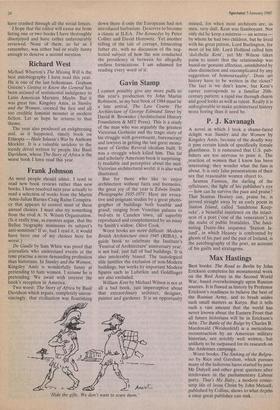Gavin Stamp
I cannot possibly give any more puffs to this year's production by John Martin Robinson, so my best book of 1984 must be a late arrival, The Law Courts: The Architecture of George Edmund Street by David B. Brownlee (Architectural History Foundation & MIT Press). This is a study of the man who was arguably the greatest Victorian Gothicist and the tragic story of his struggle with government, bureaucracy and lawyers in getting the last great monu- ment of Gothic Revival idealism built. It was a struggle which killed him. This fat and scholarly American book is surprising- ly readable and perceptive about the mid-, Victorian architectural world; it is also well illustrated.
But for those who like to enjoy architecture without facts and footnotes, the great joy of the year is Edwin Smith: Photographs 1935-1971. Here are evoca- tive and poignant studies by a great photo- grapher of buildings both humble and grand, ranging from Venetian palaces to bed-sits in Camden town, all superbly reproduced and complemented by an essay by Smith's widow, Olive Cook.
Worst books are more difficult. Modern British Architecture since 1945 (RIBA), a guide book to celebrate the Institute's 'Festival of Architecture' anniversary year,
is not bad, just full of bad buildings. It is also intolerably biased. The tautological title justifies the exclusion of non-Modern buildings, but works by important Modern figures such as Lubetkin and Goldfinger are also excluded.
William Kent by Michael Wilson is not at all a bad book, just imperceptive about
that extraordinary architect, designer, painter and gardener. It is an opportunity 'Hide the pits. We don't want to scare them.' missed, for when most architects are, as men, very dull, Kent was flamboyant. Not only did he keep a mistress — an actress — by whom he had two children, but he lived with his great patron, Lord Burlington, for most of his life. Lord Holland called him 'dukibella Kent', yet Mr Wilson takes pains to insists that the relationship was based on 'genuine affection, uninhibited by class distinction and uncomplicated by any suggestion of homosexuality'. Does art history have to be written in the closet? The fact is we don't know, but Kent's career corresponds to a familiar 20th- century pattern: a rapid rise through charm and good looks as well as talent. Really it is unforgiveable to make architectural history more boring than it need be.






































 Previous page
Previous page